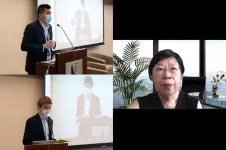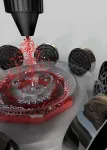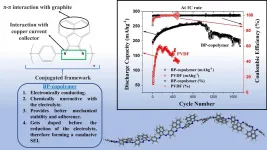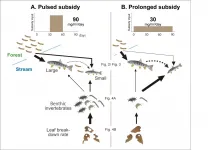(Press-News.org) SMU Office of Research & Tech Transfer - For most of human history, populations across the world lived in low-density, rural settings. Over the past few centuries, however, this changed dramatically with the trend of urbanisation. Today, more than four billion people live in urban settings worldwide; by 2050, about two thirds of the world's population are expected to live in cities.
Despite their rapid growth, cities do not spring up fully formed, but are shaped by evolving human constructs including government policy, legal frameworks and emerging technologies. It is precisely because much of human life is now led in cities that it is essential to examine these constructs and their implications on city living, said SMU President Professor Lily Kong at the New Cities in the New Normal workshop on 22 January 2021.
The workshop was coordinated by the SMU Cities Research Cluster (CRC), which comprises the School of Social Sciences (SOSS) faculty Associate Professor Winston Chow, Assistant Professor Ishani Mukherjee, Associate Professor Orlando Woods and Assistant Professor Fiona Williamson.
Building better cities
Cities today are guilty of contributing to many challenges humanity collectively faces, Professor Kong said in her opening remarks, citing the example of climate change and the corresponding need for sustainable living. This concept of sustainable living goes "far beyond" environmental issues, she qualified. It touches on social issues too - for example, ageing populations and how to sustain an elderly population in an urban environment.
This is where universities come in, providing research and education that can turn interdisciplinary, complex theories into tangible policy actions, Professor Kong explained. Concurring with Professor Kong, Professor Chow pointed out that with the recent pandemic altering countless aspects of city living, it has become even more crucial for university researchers to examine these changes in government policy, legal frameworks and emerging technologies - so as to understand their impact on cities of the future.
Agreeing that the COVID-19 outbreak has reshaped city life, Professor Shenjing He of the University of Hong Kong emphasised the issue of limited physical and social mobility. The latter is an important consideration as it is highly related to quality of life and wellbeing in cities, she said.
Moving through physical and virtual worlds
In her keynote speech, Professor He observed that as the pandemic was curtailing physical mobility - with people's movements largely restricted to their nearby communities and neighbourhoods - it was also reducing social mobility. "It's a public health crisis, but also a huge economic and social crisis... you see unemployment and economic hardship on the rise and it's hitting disadvantaged people the hardest," she said.
Since the concept of mobility also pertains to travel between cities, Professor He brought up the issue of pandemic travel bans and countries working to develop travel bubbles. "This creates a selective mobility only available to certain countries and particular [privileged] groups," she shared. "It actually signifies a more segregated and divided world."
Professor Woods further advanced this dialogue on inequality and equitable access in the next panel discussion on New Cities in the New Normal, which featured Associate Professor Hallam Stevens from NTU Institute of Science and Technology for Humanity (NISTH), and Professor Stephen Cairns, a Programme Director at the Future Cities Laboratory.
Examining the issue from a digital angle, Professor Stevens said that post-pandemic cities have grown to encompass more than the physical spaces they take up. "[They are] intertwined with all of these online spaces that we exist in at the same time. And we spend so much time in these online spaces," he said. As social distancing measures continue, human life and interactions are increasingly playing out on virtual spaces. This underscores a new need to include the novel kinds of digital rights in discussions of equitable access, Professor Stevens concluded.
Collaboration and communication
When it comes to public discussions on inequality and sustainable living, researchers can play a role in kickstarting much-needed conversations, said Professor Chow, who hosted a second panel session on urban sustainability featuring Dr Olivia Jensen, Lead Scientist for Environment and Climate at the Lloyd's Register Foundation (LRF) Institute for the Public Understanding of Risk; Dr Limin Hee, Director of Research at the Centre for Liveable Cities; and Dr Hui Mien Lee, Vice President for Sustainable Solutions at Mandai Park Development and Wildlife Reserves Singapore.
Adding to the discussion on the role of research in inspiring policy changes, the panellists concurred that much like the sprawling nature of a city, the myriad dimensions of such research would necessitate collaborations with multiple players in the ecosystem. "Academics, agencies, practitioners, developers... in coming up with integrated, systems-level solutions, we all have different roles to play," Dr Hee said.
Apart from establishing partnerships with other organisations, Dr Jensen also emphasised the importance of effective communication in turning academic studies into tangible action. "Who are the people you need to know? What are the barriers to them using it? And how can you, as a researcher, enable that process?" she asked the audience. "If you've done a great piece of work collecting and analysing data, then when it comes to communicating the results be as strategic and analytical as you would be in the research itself," she advised.
As cities continue to evolve, so too should the conversations about sustainability research, and workshops such as these, held virtually in light of the ongoing pandemic, play an important role by bringing more people into the discussion and broadening our understanding.
INFORMATION:
By Sheryl Lee
Scars inside the abdomen, known as adhesions, form after inflammation or surgery. They can cause chronic pain and digestive problems, lead to infertility in women, or even have potentially life-threatening consequences such as intestinal obstruction. If adhesions develop, they must be operated on again. They also make subsequent surgical interventions more difficult. This leads to substantial suffering for those affected and is also a significant financial burden for the healthcare system. In the USA alone, adhesions in the abdomen result in healthcare costs of 2.3 billion dollars per year.
Knowledge ...
Researchers from the University of Seville and Pompeu Fabra University argue that sports information on social media is dominated by men and football. This leaves out women's sports, sports featuring athletes with disabilities and minority disciplines, thus repeating the reality of the traditional media. That is the main conclusion of a study analysing more than 7,000 tweets published by the profiles of four public media in four European countries.
The study analysed the posts by the Twitter profiles providing sports news of the public broadcasters of Spain (RTVE), France (France TV), Ireland (RTÉ) and Italy (RAI). Between 30% and 58% of the tweets by these media related to football. However, differences were observed ...
As the source of most of the water we drink and a place where we often go to recreate and enjoy nature, streams represent a crucial point-of-contact between human beings and the environment.
Now researchers in the College of Natural Resources and Environment and the Department of Biological Systems Engineering are using stream quality data to find new insights into the interactions between the health of our natural spaces and human well-being.
Their findings, published in the journal Ecological Indicators, reveal that demographics such as race and population density, as well as health indices such as cancer rates and food insecurity, show strong correlations with water quality across the Commonwealth of Virginia.
"We started off wanting to explore the general, intuitive ...
In recent years, therapeutic antibodies have transformed the treatment of cancer and autoimmune diseases. Now, researchers at Lund University in Sweden have developed a new, efficient method based on the genetic scissors CRISPR-Cas9, that facilitates antibody development. The discovery is published in Nature Communications.
Antibody drugs are the fastest growing class of drug, and several therapeutic antibodies are used to treat cancer. They are effective, often have few side effects and benefit from the body's own immune system by identifying foreign substances in the body. ...
Researchers in the UK have developed a way to coax microscopic particles and droplets into precise patterns by harnessing the power of sound in air. The implications for printing, especially in the fields of medicine and electronics, are far-reaching.
The scientists from the Universities of Bath and Bristol have shown that it's possible to create precise, pre-determined patterns on surfaces from aerosol droplets or particles, using computer-controlled ultrasound. A paper describing the entirely new technique, called 'sonolithography', is published in Advanced Materials Technologies.
Professor Mike Fraser from the Department of Computer Science at the University of Bath, explained: "The power of ultrasound has already been shown to levitate small ...
Anyone who has owned a smartphone for over a year is most likely aware that its built-in lithium (Li)-ion battery does not hold as much charge as when the device was new. The degradation of Li-ion batteries is a serious issue that greatly limits the useful life of portable electronic devices, indirectly causing huge amounts of pollution and economic losses. In addition to this, the fact that Li-ion batteries are not very durable is a massive roadblock for the market of electric vehicles and renewable energy harvesting. Considering the severity of these issues, it is no surprise that researchers have been actively ...
In recent years, researchers have begun using functional magnetic resonance imaging (fMRI) not just for better understanding the neural bases of psychiatric illness, but also for experimental treatment of depression, ADHD, anxiety, PTSD, substance use disorder, and schizophrenia with a technique called real-time fMRI neurofeedback.
While rtfMRI-NF has emerged in recent years as a promising experimental intervention, it's also a costly procedure that requires extensive technical setup to allow for real-time analysis. That's why a quantitative data review was overdue.
A team of END ...
In the brain, billions of neurons reach to each other, exchanging information, storing memories, reacting to danger and more. Scientists have barely scratched the surface of the most complex organ, but a new device to automatically collect tissue for analysis may allow for a quicker, deeper dive into the brain.
Their approach was published in IEEE/CAA Journal of Automatica Sinica, a joint publication of the IEEE and the Chinese Association of Automation.
"The ultimate goal of this study is to further promote the speed and quality of 3D-reconstruction of brain neural connections," said the author Long ...
Insects that fall from the surrounding forest provide seasonal food for fish in streams. Researchers at Kobe University and The University of Tokyo have shown that the lengthening of this period has a profound effect on food webs and ecosystem functions present in streams.
These research results provide proof that changes in forest seasonality also affect the ecosystems of nearby rivers. This finding highlights the importance of predicting the effects of climate change on ecosystems.
The research group consisted of Associate Professor SATO Takuya and post-graduate student UEDA Rui of Kobe University's Graduate ...
In a new study by the Yale Department of Immunobiology and Yale Cancer Center, researchers report combined liver and growth factor humanization enhances human red blood cell production and survival in circulation the immunodeficient murine host. The discovery could help in the development of treatments of life-threatening blood disorders, such as myelodysplastic syndrome, and diseases afflicting red blood cells, including sickle cell disease and malaria. The study is published online today in the journal Science.
"Red blood cell diseases, such as thalassemia and sickle cell disease involve approximately 5% of ...






